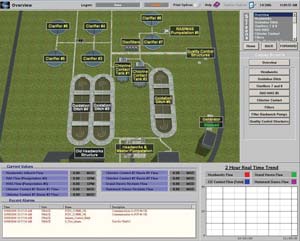
Case study: Palm Coast Wastewater Facility Upgrade
 The Plan: Expand and upgrade the existing wastewater treatment facility to accommodate a population growth rate of approximately 107 percent over five years. The plant must be able to treat 3 million gallons of wastewater per day (mgd) with a maximum capacity of 5 mgd. The upgrade includes building a second treatment train that consists of a new headworks building, oxidation ditch, two clarifiers, return activated sludge/waste activated sludge pump station, chlorine contact chamber, and disc filters.
The Plan: Expand and upgrade the existing wastewater treatment facility to accommodate a population growth rate of approximately 107 percent over five years. The plant must be able to treat 3 million gallons of wastewater per day (mgd) with a maximum capacity of 5 mgd. The upgrade includes building a second treatment train that consists of a new headworks building, oxidation ditch, two clarifiers, return activated sludge/waste activated sludge pump station, chlorine contact chamber, and disc filters.
Step 1: Assemble a project team. The city contracted CPH Engineers of Palm Coast for the design of the civil and process work and Bailey Engineering of Delray Beach, Fla., for the design of the power and automation portion. Kruger Inc. of Cary, N.C., was chosen to provide the oxidation ditch and disc filters and to supply the automation system and motor control centers.
Step 2: Design a control system. The automation team developed an Ethernet-based process control system. The companies chose the open Modbus TCP protocol to ensure the city wouldn't be limited to proprietary hardware of a proprietary network for any future upgrades.
They used Square D Model 6 Intelligent Motor Control Centers (iMCCs) with embedded Ethernet to provide the city with advanced diagnostic capabilities.
The companies also chose an automation system that consists of two separate Telemecanique Modicon Quantum TM programmable automation controllers (PACs) from Schneider Electric. Each PAC communicates to a dedicated remote rack and gathers flow, dissolved oxygen, and run-status information from each area of the plant. This information is then transmitted over the same Ethernet network that the iMCCs use. The PACs also control the starters, variable frequency drives, and soft starts embedded in the iMCCs. Results: Using Ethernet networks allows the municipality to monitor approximately 1,500 points of data, giving operators a full view of their facility. Operators can access the plant offsite via a dial-in connection and alarm dialer, minimizing the possibility of process upsets due to equipment failure during off-hours.
This case study originally appeared in the October 2007 print issue of Water & Wastewater News.